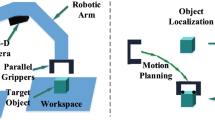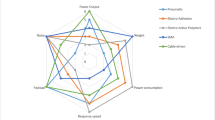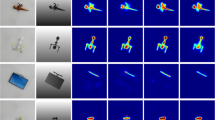Abstract
This paper presents a decision-theoretic approach to problems that require accurate placement of a robot relative to an object of known shape, such as grasping for assembly or tool use. The decision process is applied to a robot hand with tactile sensors, to localize the object on a table and ultimately achieve a target placement by selecting among a parameterized set of grasping and information-gathering trajectories. The process is demonstrated in simulation and on a real robot. This work has been previously presented in Hsiao et al. (Workshop on Algorithmic Foundations of Robotics (WAFR), 2008; Robotics Science and Systems (RSS), 2010) and Hsiao (Relatively robust grasping, Ph.D. thesis, Massachusetts Institute of Technology, 2009).
Similar content being viewed by others
References
Akella, S., & Mason, M. T. (1999). Using partial sensor information to orient parts. The International Journal of Robotics Research, 18(10), 963–997.
Allen, P. K., & Bajcsy, R. (1985). Object recognition using vision and touch. In Intl. joint conf. on artificial intelligence (IJCAI).
Allen, P. K., & Michelman, P. (1990). Acquisition and interpretation of 3-D sensor data from touch. IEEE Transactions on Robotics and Automation, 6(4), 397–404.
Alterovitz, R., Simeon, T., & Goldberg, K. (2007). The stochastic motion roadmap: a sampling framework for planning with markov motion uncertainty. In Robotics science and systems (RSS).
Baum, C. W., & Veeravalli, V. V. (1994). A sequential procedure for multihypothesis testing. IEEE on Information Theory, 40(6). doi:10.1109/18.340472.
Burns, B., & Brock, O. (2007). Sampling-based motion planning with sensing uncertainty. In IEEE intl. conf. on robotics and automation (ICRA).
Cameron, A., & Durrant-Whyte, H. F. (1990). A Bayesian approach to optimal sensor placement. The International Journal of Robotics Research, 9(5), 70–88.
Censi, A., Calisi, D., Luca, A. D., & Oriolo, G. (2008). A bayesian framework for optimal motion planning with uncertainty. In IEEE intl. conf. on robotics and automation (ICRA) (pp. 1798–1805).
DeGroot, M. H. (1970). Optimal statistical decisizons. New York: McGraw-Hill.
Diankov, R., & Kuffner, J. (2008). Openrave: a planning architecture for autonomous robotics (Tech. Rep. CMU-RI-TR-08-34). Robotics Institute, CMU.
Ellis, R. E. (1992). Planning tactile recognition paths in two and three dimensions. The International Journal of Robotics Research, 11(2), 87–111.
Erdmann, M. (1998). Shape recovery from passive locally dense tactile data. In Workshop on algorithmic foundations of robotics (WAFR).
Erickson, L. H., Knuth, J., O’Kane, J. M., & Lavalle, S. M. (2008). Probabilistic localization with a blind robot. In IEEE intl. conf. on robotics and automation (ICRA).
Gadeyne, K., Lefebvre, T., & Bruyninckx, H. (2005). Bayesian hybrid model-state estimation applied to simultaneous contact formation recognition and geometrical parameter estimation. The International Journal of Robotics Research, 24, 615.
Gaston, P. C., & Lozano-Perez, T. (1984). Tactile recognition and localization using object models: The case of polyhedra on a plane. IEEE Transactions on Pattern Analysis and Machine Intelligence, 6, 257–265.
Gonzalez, J. P., & Stentz, A. (2005). Planning with uncertainty in position an optimal and efficient planner. In IEEE/RSJ intl. conf. on intelligent robots and systems (IROS) (pp. 2435–2442).
Hsiao, K. (2009). Relatively robust grasping. Ph.D. thesis, Massachusetts Institute of Technology.
Hsiao, K., Kaelbling, L. P., & Lozano-Perez, T. (2007). Grasping POMDPs. In IEEE intl. conf. on robotics and automation (ICRA).
Hsiao, K., Kaelbling, L. P., & Lozano-Perez, T. (2008). Robust belief-based execution of manipulation programs. In Workshop on algorithmic foundations of robotics (WAFR).
Hsiao, K., Kaelbling, L. P., & Lozano-Perez, T. (2010). Task-driven tactile exploration. In Robotics science and systems (RSS).
Kaelbling, L. P., Littman, M. L., & Cassandra, A. R. (1998). Planning and acting in partially observable stochastic domains. Artifical Intelligence, 101. doi:10.1016/S0004-3702(98)00023-X.
Krause, A., & Guestrin, C. (2007). Near-optimal observation selection using submodular functions. In Conf. on artificial intelligence (AAAI).
Latombe, J. (1991). Robot motion planning. Dordrecht: Kluwer Academic.
LaValle, S. M. (2006). Planning algorithms. Cambridge: Cambridge University Press.
Lozano-Perez, T., Mason, M. T., & Taylor, R. H. (1984). Automatic synthesis of fine-motion strategies for robots. International Journal of Robotics Research (IJRR), 3(1). doi:10.1177/027836498400300101.
Melchior, N. A., & Simmons, R. (2007). Particle rrt for path planning with uncertainty. In IEEE intl. conf. on robotics and automation (ICRA).
Okada, T., & Tsuchiya, S. (1977). Object recognition by grasping. Pattern Recognition, 9(3), 111–119.
Okamura, A. M., & Cutkosky, M. R. (2001). Feature detection for haptic exploration with robotic fingers. The International Journal of Robotics Research, 20(12), 925–938.
Petrovskaya, A., & Ng, A. Y. (2007). Probabilistic mobile manipulation in dynamic environments, with application to opening doors. In Intl. joint conf. on artificial intelligence (IJCAI).
Prentice, S., & Roy, N. (2007). The belief roadmap: efficient planning in linear POMDPs by factoring the covariance. In Intl. symposium on robotics research (ISRR).
Skiena, S. (1989). Problems in geometric probing. Algorithmica, 4(4), 599–605.
Taylor, R. H., Mason, M. T., & Goldberg, K. Y. (1988). Sensor-based manipulation planning as a game with nature. In Intl. symposium on robotics research (ISRR).
Wald, A. (1945). Sequential tests of statistical hypotheses. The Annals of Mathematical Statistics, 16(2). doi:10.1214/aoms/1177731118.
Author information
Authors and Affiliations
Corresponding author
Rights and permissions
About this article
Cite this article
Hsiao, K., Kaelbling, L.P. & Lozano-Pérez, T. Robust grasping under object pose uncertainty. Auton Robot 31, 253–268 (2011). https://doi.org/10.1007/s10514-011-9243-2
Received:
Accepted:
Published:
Issue Date:
DOI: https://doi.org/10.1007/s10514-011-9243-2




